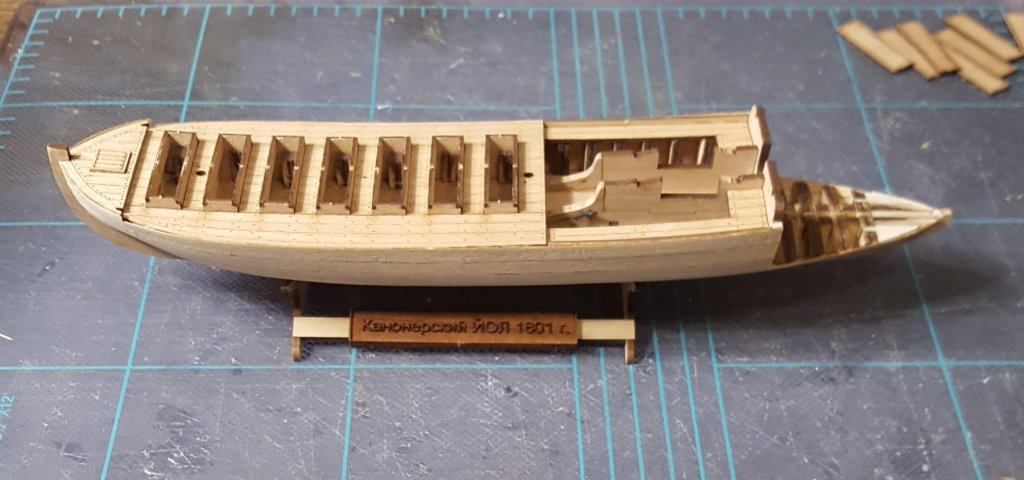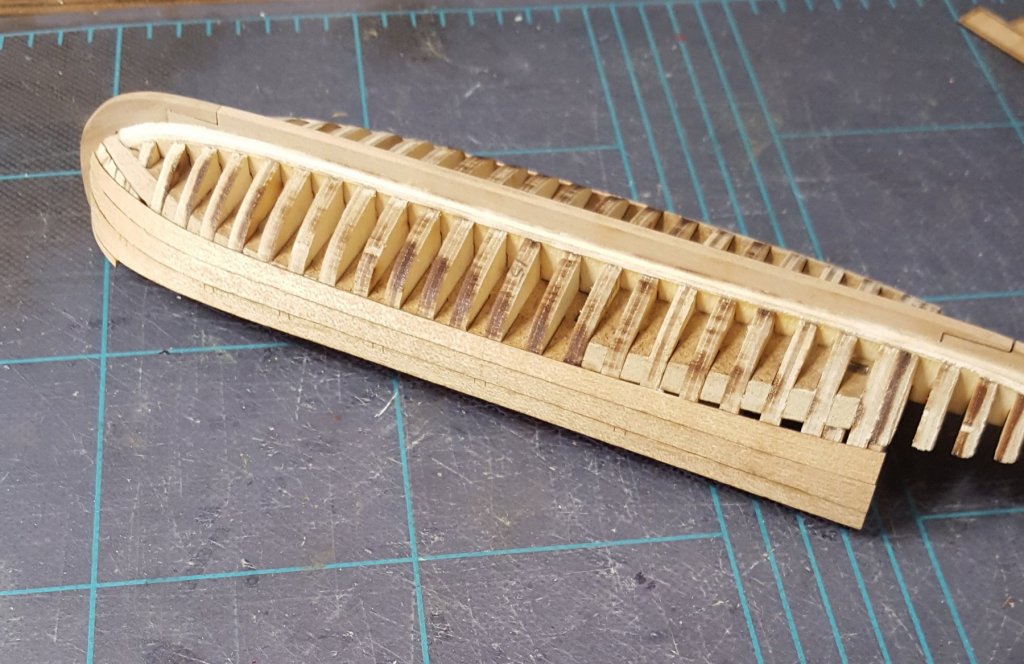-
Posts
10,370 -
Joined
-
Last visited
Content Type
Profiles
Forums
Gallery
Events
Everything posted by ccoyle
-
Wow! You are really making some quick progress on this!
- 87 replies
-
- scottish maid
- artesania latina
-
(and 1 more)
Tagged with:
-
I work with a guy from Finland, which I dare say isn't all that common on this side of the pond.
-
Hi, Adrie. For perspective, the blue squares on the cutting mat are 5 cm on a side. Not trying to be unduly modest, but a lot of the "smashing-ness" of the model is really due to the excellent design of the kit and not so much to any great skill on my part. Thanks for commenting!
- 117 replies
-
Hull planking completed and sanded. This is as far as I will get before traveling over Christmas break. Construction will resume in the new year.
- 117 replies
-
Just remember, Jeff, that there are two components of any completion ratio data set: those who don't finish, but also those who do. We do occasionally see some of the latter, so keep at it, and hopefully we'll see you join that select group. Cheers!
-
I don't know, but try searching (either here or on the Internet in general) for build logs of Shipyard kits. You might find how they plan for that task. Good luck!
- 355 replies
-
- prince de neufchatel
- schooner
-
(and 3 more)
Tagged with:
-
Yup, you have a challenging kit there! Fortunately, there are a lot of Victory build logs here, and you should be able to find what you need. Cheers!
-
Scott, If a sail was not bent (i.e. attached) to its yard, any running rigging that attached directly to the sail would be down as well.
-
Hmm. This one is a little different than what we usually see around here. I have a few preliminary thoughts. 1. I don't believe that this is a mass-produced decorative model, as those tend to be purported reproductions of famous ships, and K. D. Echoes is definitely not a famous ship. 2. On the other hand, someone could have purchased just such a model and then endeavored to personalize it by adding the name. 3. The rig on the model is odd, because the topsails have gaffs. This might have been seen on early 19th-century schooners, but almost certainly not on one in 1930. 4. So my "educated" (for whatever that's worth) guess is that this is a scratch-built model based on someone's idea of what a schooner looks like (as opposed to built from plans or a kit), and that the name and date have some sort of personal significance to the builder; e.g. "K.D." could be someone they knew, and 1930 might be the year the model was built. The true story is probably lost to history. Thanks for sharing!
-

Error in kit and asking for advise
ccoyle replied to Ulises Victoria's topic in Masting, rigging and sails
Can't hurt. -
I have found quilting thread to be a good choice. It's pretty heavy-duty and has a lot less fuzz than regular sewing thread.
- 64 replies
-
- v108
- digital navy
-
(and 2 more)
Tagged with:
-
Slow progress ... a couple of planks here, a couple of planks there as time and interest allow. Twelve strakes on, six more to go. Did a little preliminary sanding and temporarily fitted the display cradle together, just for this shot.
- 117 replies
-
Welcome! Several times on Facebook I have seen a video of some chocolatiers making a ship out of chocolate, so gingerbread does not strike me as all that far-fetched. Have fun thinking about what model to build!
-
Hi, Scott! Not to confuse the issue, but have you considered any of the other Bounty kits out there, e.g. Amati, Billing Boats, or Caldercraft? I haven't built any of them, so I can't offer an opinion one way or the other.
-
Glad to see you making an attempt at this! I won't complain about your "deviating" from the tutorial -- I never make any claims to know the "only" (or even the "best") way to do this stuff. If anyone can make such a claim, it's probably either Danny or Doris. Keep up the good work!
- 10 replies
-
- v108
- digital navy
-
(and 1 more)
Tagged with:
-
Welcome! Midwest models are great first-time projects. I'm not sure about the whole "paint with lacquer" thing for sails (at least I've never done it) -- maybe they're thinking about getting the sail to hold a wind-filled shape? Anyways, I don't think that step is completely necessary. Just remember to give the sail cloth a good ironing to get all the wrinkles out. Cheers!
-
Got the first six strakes glued on, three per side. Sharp-eyed members will notice that I had a lapse in heeding my own advice about reading ahead; this resulted in my adding the keel pieces too early. They're supposed to be added after the planking is done. Oh, well -- not like I haven't planked a hull before with the keel already installed🙄. It's nice to have a rock-solid substructure to glue planks to.
- 117 replies
About us
Modelshipworld - Advancing Ship Modeling through Research
SSL Secured
Your security is important for us so this Website is SSL-Secured
NRG Mailing Address
Nautical Research Guild
237 South Lincoln Street
Westmont IL, 60559-1917
Model Ship World ® and the MSW logo are Registered Trademarks, and belong to the Nautical Research Guild (United States Patent and Trademark Office: No. 6,929,264 & No. 6,929,274, registered Dec. 20, 2022)
Helpful Links
About the NRG
If you enjoy building ship models that are historically accurate as well as beautiful, then The Nautical Research Guild (NRG) is just right for you.
The Guild is a non-profit educational organization whose mission is to “Advance Ship Modeling Through Research”. We provide support to our members in their efforts to raise the quality of their model ships.
The Nautical Research Guild has published our world-renowned quarterly magazine, The Nautical Research Journal, since 1955. The pages of the Journal are full of articles by accomplished ship modelers who show you how they create those exquisite details on their models, and by maritime historians who show you the correct details to build. The Journal is available in both print and digital editions. Go to the NRG web site (www.thenrg.org) to download a complimentary digital copy of the Journal. The NRG also publishes plan sets, books and compilations of back issues of the Journal and the former Ships in Scale and Model Ship Builder magazines.





